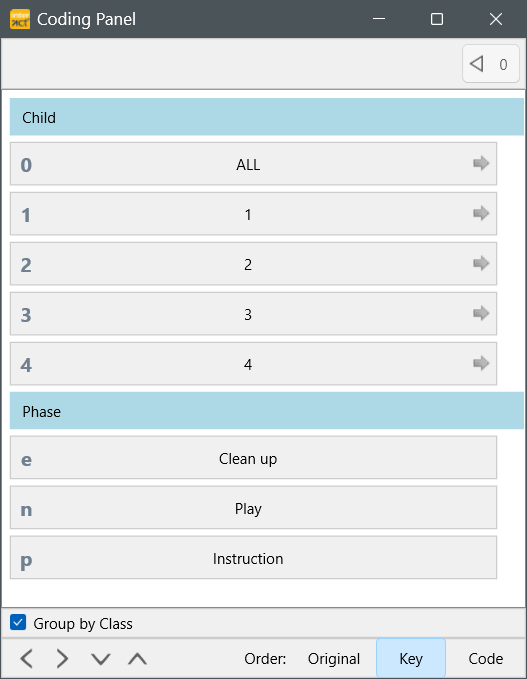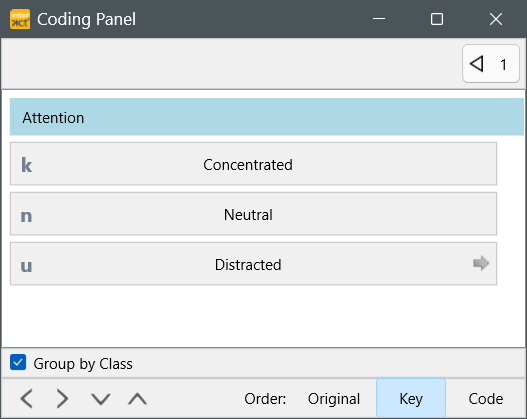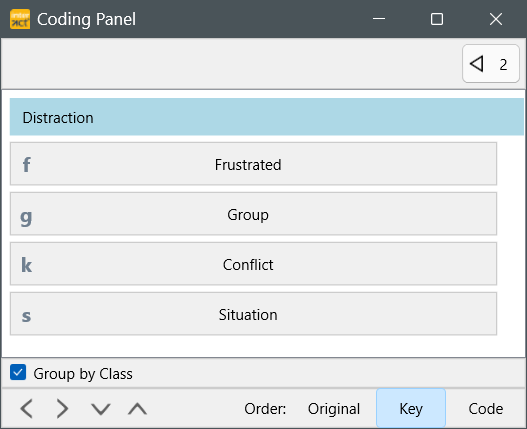Note: The main difference between the coding modes Lexical and Complex is, that with lexical coding the additional Codes are entered AFTER the Event is closed, whereas in the Complex mode the additional Codes are entered directly at the START of the each Event, leaving the Event open for a long as this behavior lasts.
The process of logging Events, using the Complex coding mode, works like this:
▪Open a top-level 'Master' Code definition file, within the Code definitions dialog.
▪Make sure you have selected the coding mode Complex.
▪Click ![]() to activate the observation mode.
to activate the observation mode.
Specify the starting situation for each subject:
▪Press a [key] from the top-level Codes, or click a subject in the Coding panel.
A new Event with start time is created.
Immediately, the next level Codes are shown in the Coding panel, to specify the situation for the selected subject. After specification, INTERACT switches back to the top level 'master' Codes.
▪Click on the next subject and specify its situation, just like before.
This information is stored in a second Event, without closing the first.
▪Start an Event for each subject, following the same steps again and again.
Once an Event is created for each subject and maybe some additional Codes, it is time to start the video:
▪Click ![]() Play to start the video.
Play to start the video.
The moment the situation changes for one of your subjects:
▪Click the subject Code and specify its new situation.
INTERACT closes the previous Event for this subject, using the time information from the moment you clicked. A new Event is created, starting from that point in time, to store the details on the new situation.
This process creates multiple, continuous Event strings. One for each subject. All Events are logged with duration!
IMPORTANT: The multimedia file(s) do not pause automatically!
*) The terms 'subject' and 'behavior' should be considered rather broadminded, because codes could also be used for e.g. counts in different areas and the 'Master' objects do not necessarily need to be people or animals but could be used to describe e.g. accommodations or areas.
Group therapy
If we perform the steps described above, with the Code definitions from our example situation in Define Codes for Complex Coding Mode, it works like this:
▪Open the code definition file 01_Actors.ikey.
▪Open your multimedia file(s).
▪Click ![]() to activate the Observation mode.
to activate the Observation mode.
▪The Coding panel appears, showing the available first level codes:

▪Click on the Code that specifies the first child.
The Coding panel immediately switches to the second level Codes:

▪Click the code that represents the Attention for this child.
▪In case you click Distracted, the Coding panel switches to the third level Codes:

▪In case you clicked any of the other attention Codes (or after you specified the source of distraction in the third level Codes) the Coding panel switches back to the top-level Codes.
▪Click the Code for the next Child and continue as before.
After all children are rated, the current Phase needs to be set as well:
▪Click Instruction to specify the start of this first phase.
You data file now looks something like this, although the video has not started yet:
▪Click Play ![]() to start the video.
to start the video.
▪The moment the attention of one of the children changes, click this child again and specify the new situation.
Note: Other step by step examples are described in Observe Animal Interaction and Fluctuation Observation.
